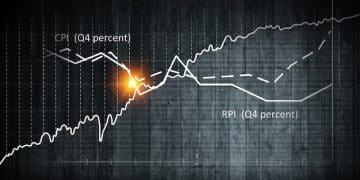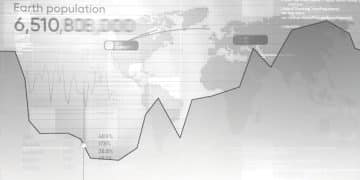US National Debt Hits Record: Long-Term Consequences Unpacked

The US national debt reaching an unprecedented high signals potential long-term consequences, including elevated inflation risk, higher interest rates, and reduced fiscal flexibility for future economic challenges, impacting every American.
The relentless climb of the US national debt to record highs: What Are the Long-Term Consequences? This escalating fiscal challenge isn’t just a number; it represents a complex web of economic pressures that could reshape America’s financial future for generations.
Understanding the Unprecedented Accumulation
The sheer scale of the US national debt can be difficult to grasp. It’s a cumulative figure representing all money borrowed by the federal government over its history, minus the portion that has been repaid. This debt is largely held by public investors, including individuals, corporations, state and local governments, and foreign entities, as well as by government accounts like Social Security trust funds.
Several factors have historically contributed to this consistent upward trend. Wars, economic recessions, and significant policy changes all play a role in increasing government spending without a proportional rise in revenues. The modern era has seen rapid acceleration, driven by a combination of factors that, individually, might seem manageable but collectively have created an unprecedented fiscal burden.
Key Drivers of Recent Debt Growth
Examining the primary contributors is crucial to understanding the current predicament. Economic downturns often trigger increased government spending on social safety nets and stimulus packages, while tax cuts can reduce federal revenues. These combined pressures contribute significantly to the burgeoning debt.
- Economic Crises and Recessions: Major downturns like the 2008 financial crisis and the COVID-19 pandemic necessitated massive federal outlays for economic stabilization, unemployment benefits, and business support programs.
- Demographic Shifts: An aging population in the US leads to increased expenditures on entitlement programs such as Social Security and Medicare, which are primarily funded through payroll taxes.
- Tax Policy Changes: Reductions in tax rates, particularly for corporations and high-income earners, can decrease government revenue, thereby increasing the reliance on borrowing to cover expenditures.
- Defense Spending: Sustained and substantial military expenditures, including ongoing operations and modernization efforts, constitute a significant portion of the federal budget.
Beyond these specific drivers, a structural imbalance often exists between federal revenues and mandatory spending. This means that even without new policy initiatives, existing commitments for programs like Social Security and Medicare, coupled with interest payments on existing debt, consume a growing share of the budget, leaving less room for discretionary spending or deficit reduction.
The accumulation reflects not just immediate policy choices, but long-term trends and systemic issues within the US fiscal framework. As a result, the national debt isn’t merely an abstract concept; it’s a tangible economic force with far-reaching implications that demand careful consideration and proactive strategy.
Immediate Economic Repercussions: Interest Rates and Inflation
The immediate effects of a soaring national debt are often felt through shifts in key economic indicators, most notably interest rates and inflation. These impacts are not theoretical; they directly influence the daily financial lives of Americans, from mortgage payments to the price of consumer goods. As the government borrows more, it competes with private sector borrowers for available capital, driving up the cost of money.
When the US Treasury issues new bonds to finance the debt, it increases the supply of government debt in the market. To attract investors, especially as the volume of available bonds rises, the Treasury may need to offer higher interest rates. This increase in government borrowing costs can then ripple through the broader economy, affecting private borrowing rates.
The Ripple Effect on Borrowing Costs
Higher government borrowing costs can translate into elevated interest rates for consumers and businesses. This is a direct consequence of increased demand for capital by the government, which reduces the pool of funds available for private loans, thereby making them more expensive.
- Mortgage Rates: An increase in Treasury yields often leads to higher fixed-rate mortgage interest rates, making housing less affordable for new homebuyers and increasing costs for those looking to refinance.
- Business Loans: Companies face higher borrowing costs for expansion, investment, and operations, which can stifle economic growth and job creation.
- Consumer Credit: Rates on credit cards, auto loans, and other forms of consumer debt may also rise, reducing disposable income and slowing consumer spending.
The impact extends beyond new borrowing. Existing variable-rate loans also become more expensive, placing an additional financial burden on households and businesses. This tightens financial conditions more broadly, potentially slowing down economic activity.

Inflationary Pressures and Purchasing Power
Another significant immediate concern is the potential for increased inflation. While not always a direct consequence, a high and rising debt can contribute to inflationary pressures, particularly if the Federal Reserve monetizes the debt (i.e., buys large quantities of government bonds, effectively printing money).
When the government spends borrowed money, it injects more demand into the economy. If this demand outstrips the economy’s productive capacity, it can lead to higher prices. This is especially true if the borrowing is seen as unsustainable, eroding confidence in the currency’s value.
A persistent increase in the money supply without a corresponding increase in goods and services can devalue the currency, leading to purchasing power erosion. This means that a dollar buys less over time, impacting savings, fixed incomes, and the overall cost of living for American families.
These immediate repercussions – higher interest rates and inflationary pressures – underscore the fragility of an unchecked debt trajectory. While a certain level of debt is normal for a developed economy, its rapid ascent to record highs introduces significant complexities and potential instability, demanding both vigilance and strategic foresight from policymakers.
Fiscal Challenges and Reduced Policy Flexibility
Beyond the immediate market reactions, a burgeoning national debt significantly constrains the government’s fiscal flexibility, severely limiting its ability to respond to future crises or invest in critical areas. A substantial portion of the federal budget becomes earmarked for servicing the debt, reducing the resources available for discretionary spending on domestic programs, infrastructure, research, and development. This is a critical long-term consequence that affects national resilience and future prosperity.
Each dollar spent on interest payments is a dollar that cannot be allocated to education, healthcare, national defense, or even tax relief. As interest rates rise, this drain on the budget intensifies, creating a compounding challenge that becomes increasingly difficult to reverse. The government’s fiscal toolkit becomes blunted, leaving fewer options when faced with economic downturns or unforeseen emergencies.
The Increasing Burden of Debt Servicing
As the national debt grows, so does the amount the government must pay in interest to its creditors. These interest payments themselves can become a significant budgetary burden, potentially crowding out other essential government spending.
- Budgetary Constraints: A larger share of the federal budget dedicated to interest payments means less money is available for other priorities like education, infrastructure, scientific research, or poverty reduction programs.
- Reduced Response Capacity: In the event of a future recession, natural disaster, or geopolitical crisis, the government might have less fiscal room to enact necessary stimulus measures or provide emergency relief without further exacerbating the debt problem.
- Credit Rating Concerns: Prolonged and unsustainable debt trajectories can lead to downgrades in the nation’s credit rating, potentially increasing future borrowing costs and investor skepticism.
This escalating cost of debt servicing creates a feedback loop: higher debt leads to higher interest payments, which in turn contribute to larger deficits and even more debt. Breaking this cycle requires significant political will and strategic fiscal planning.
Impact on Future Generations and Public Services
Perhaps one of the most profound long-term consequences is the intergenerational transfer of debt. Today’s borrowing is effectively tomorrow’s tax burden or reduced public services. Future generations will bear the brunt of managing this debt, either through higher taxes, less government spending, or both.
Government services, from social security benefits to environmental protection agencies, could face budget cuts or reduced funding if the fiscal strain becomes too great. This isn’t just an economic issue; it’s a social contract issue, where current consumption is financed by future obligations, potentially compromising the quality of life for those to come.
The reduced policy flexibility isn’t an abstract concept; it translates into real-world limitations. It means fewer new roads, less investment in renewable energy, and potentially constrained responses to public health crises. Addressing the looming fiscal challenge is therefore not just about balancing books; it’s about safeguarding America’s capacity to innovate, adapt, and provide for its citizens in the decades ahead.
Impact on International Standing and Investor Confidence
The scale of the US national debt is not merely a domestic concern; it has significant implications for America’s international standing and global investor confidence. As the world’s largest economy and holder of the primary reserve currency, the US dollar, the fiscal health of the United States resonates across global markets. A persistently high and rising debt can lead to concerns among international creditors and geopolitical rivals alike, potentially eroding financial credibility and diplomatic influence.
When foreign governments and international investors assess the stability of a nation, its public debt levels are a critical indicator. A perceived lack of fiscal discipline or an inability to manage mounting debt could lead to a reassessment of the dollar’s status as a safe haven asset and a global reserve currency, consequences that would have profound and far-reaching economic impacts.
Erosion of the Dollar’s Reserve Status
The US dollar has long enjoyed its status as the world’s primary reserve currency, a position that grants the United States significant economic advantages. This includes lower borrowing costs and greater geopolitical leverage. However, this status is not immutable.
If global investors begin to question the long-term solvency of the US due to its debt trajectory, they might gradually shift their reserves into other currencies or assets. Such a shift, even a partial one, could have several adverse effects.
- Higher Borrowing Costs: Demand for US Treasuries could decrease, forcing the US to offer higher interest rates to attract buyers, thereby increasing the cost of servicing the national debt.
- Devaluation of the Dollar: A decline in demand for the dollar could lead to its depreciation against other major currencies, making imports more expensive for American consumers and businesses.
- Loss of Influence: The ability to conduct international trade and finance in dollars provides the US with substantial influence. Erosion of this status could diminish America’s global economic and political leverage.
The risk isn’t an immediate collapse, but a gradual erosion of confidence that, over time, can prove difficult to reverse. Maintaining the dollar’s prestige is intrinsically linked to showcasing fiscal responsibility.

Geopolitical Implications and Competitor Advantages
Beyond economic considerations, a weakened fiscal position can have significant geopolitical ramifications. Nations with strong, stable economies tend to possess greater diplomatic and military leverage. A nation perceived as fiscally vulnerable might find its influence diminished on the global stage.
Competitor nations, particularly those seeking to challenge US dominance, could leverage the narrative of American fiscal irresponsibility. This could manifest in attempts to promote alternative reserve currencies, forge new trade blocs that exclude the US, or simply undermine confidence in the American model of democratic capitalism.
A nation burdened by debt may also find itself less able to project power or respond to global challenges effectively, as resources become constrained domestically. This could create vacuums that rival powers are eager to fill, altering the global balance of power. Therefore, managing the national debt isn’t just an economic imperative; it’s a strategic one, vital for maintaining America’s leadership and security in a complex world.
Potential Economic Slowdown and Reduced Growth
One of the most concerning long-term consequences of a continually expanding national debt is its potential to stifle economic growth. While government spending can stimulate the economy in the short term, particularly during recessions, persistent large deficits and accumulating debt can paradoxically lead to slower growth over the long run. This effect is often described through various mechanisms, including crowding out private investment and increasing economic uncertainty.
As the government borrows more, it competes with businesses and individuals for limited capital. This competition can drive up interest rates, making it more expensive for the private sector to borrow and invest. This phenomenon, known as “crowding out,” can divert capital from productive private investments that would otherwise fuel innovation, job creation, and long-term economic expansion.
Crowding Out Private Investment
The theory of crowding out posits that when the government increases its borrowing, it reduces the amount of financial capital available for private investment. This can undermine the foundational drivers of sustainable economic growth.
- Higher Interest Rates: Increased government demand for loans pushes up interest rates, discouraging businesses from borrowing to expand or embark on new projects, and deterring individuals from taking on mortgages or other loans.
- Reduced Capital Formation: Less private investment means slower growth in productive capacity, technological advancements, and overall economic output.
- Slower Innovation: If capital is diverted from private research and development due to higher borrowing costs, the pace of innovation can slow, affecting long-term competitiveness.
The net effect is a less dynamic and less productive economy in the future. The government’s gain in immediate spending comes at the cost of diminished private sector vitality, eventually leading to lower living standards.
Increased Economic Uncertainty and Business Hesitation
Beyond direct financial effects, a rapidly growing national debt can create an atmosphere of economic uncertainty. Businesses, investors, and consumers become concerned about future tax increases, potential inflationary spirals, or a future fiscal crisis. This uncertainty can lead to caution and hesitation, further hindering economic activity.
When the future is unclear, businesses may delay expansion plans, reduce hiring, or postpone investment in new technologies. Consumers might save more and spend less, anticipating future economic difficulties. This collective cautious behavior can become a self-fulfilling prophecy, contributing to slower economic growth even before any direct fiscal measures are implemented.
Furthermore, the unpredictability regarding how the debt might eventually be addressed (e.g., through significant tax hikes, spending cuts, or even inflation) can deter both domestic and foreign investment. This climate of uncertainty makes long-term planning difficult, and capital tends to flow to more predictable and fiscally stable environments. Therefore, managing the national debt is not just about avoiding crisis; it’s about fostering an environment of stability that encourages robust and sustained economic growth.
Social and Political Dimensions of Debt
The consequences of a soaring national debt extend far beyond purely economic indicators; they deeply permeate the social fabric and political landscape of a nation. Persistent fiscal challenges can exacerbate social inequalities, strain intergenerational solidarity, and intensify political polarization, making meaningful solutions ever more elusive. This debt is not just a financial burden; it’s a potential source of significant societal friction.
When difficult choices about taxation, spending cuts, or inflation must be made to address the debt, different segments of society inevitably bear disproportionate burdens. This can lead to resentment, a perception of unfairness, and increased social unrest, especially if certain groups feel marginalized or unfairly targeted by fiscal adjustments.
Exacerbating Social Inequalities
Debt management strategies often have uneven impacts. For instance, austerity measures might cut public services or social safety nets that disproportionately benefit lower-income households. Conversely, if inflation is used to implicitly reduce the debt burden, those on fixed incomes or with fewer assets may suffer the most from a decline in purchasing power.
- Strain on Social Programs: Critical social programs, from education to healthcare and assistance for vulnerable populations, may face funding cuts as debt servicing demands a larger share of the budget.
- Intergenerational Equity: The transfer of debt to future generations raises questions of intergenerational equity, as younger cohorts may face higher taxes or reduced benefits to pay for current consumption.
- Wealth Distribution: Policies addressing debt, whether through taxation or inflation, can impact wealth distribution, potentially widening the gap between the rich and the poor.
These dynamics can lead to increased poverty, reduced access to essential services for marginalized communities, and a general decline in the quality of life for a significant portion of the population.
Heightened Political Polarization and Governance Challenges
Addressing the national debt requires difficult trade-offs and bipartisan cooperation, a challenge made more formidable in an era of heightened political polarization. Debates over tax increases versus spending cuts, or which programs to prioritize, can become fiercely contentious, often paralyzing legislative efforts.
The complexity and long-term nature of the debt problem make it susceptible to short-sighted political decision-making. Politicians may be hesitant to embrace unpopular but necessary measures, fearing electoral repercussions. This can lead to a cycle of kicking the can down the road, allowing the problem to grow larger and more intractable over time. The inability to reach consensus on fiscal sustainability can erode public trust in government institutions.
Furthermore, external pressures from creditors or international bodies to address the debt can be perceived as infringements on national sovereignty, adding another layer of political complexity. Ultimately, a nation’s ability to govern effectively and maintain social cohesion can be severely tested by the relentless pressure of an escalating national debt, underscoring the necessity of proactive and collaborative solutions that look beyond immediate political cycles.
Strategies for Fiscal Sustainability: Paths Forward
While the long-term consequences of a burgeoning national debt are daunting, they are not inevitable. There are concrete strategies and policy approaches that can be pursued to promote fiscal sustainability and mitigate the risks associated with record-high borrowing. These paths forward typically involve a combination of revenue enhancement, expenditure control, and fostering robust economic growth. Each approach presents its own set of challenges and trade-offs, requiring careful consideration and political consensus.
The goal is not necessarily to eliminate the debt entirely, but to ensure its growth is sustainable relative to the size of the economy and that the government retains sufficient fiscal flexibility. This requires a balanced approach, avoiding measures that might inadvertently trigger economic slowdowns while still making meaningful progress on fiscal consolidation.
Revenue Enhancement and Expenditure Control
The most direct ways to address the debt involve either increasing government revenues or decreasing government spending. These are often the most politically contentious areas, but also the most impactful.
- Tax Policy Reforms: This could include adjustments to income tax rates, corporate taxes, consumption taxes, or closing tax loopholes to broaden the tax base and increase federal revenue.
- Spending Review and Reductions: A comprehensive review of government programs could identify areas for efficiency gains, cost reductions, or re-prioritization of spending. This includes both discretionary spending and entitlement programs, which constitute a significant portion of the budget.
- Combating Waste and Fraud: Efforts to reduce waste, fraud, and abuse in government programs can also free up significant resources, contributing to fiscal health without cuts to essential services.
Any adjustments must be carefully calibrated to avoid undue hardship on vulnerable populations or stifling economic activity. The key is to find a balance that raises necessary revenue and controls spending without derailing economic growth.
Fostering Economic Growth and Productivity
Perhaps the most palatable, though often the most challenging, strategy for debt reduction is accelerating economic growth. A larger and more productive economy generates more tax revenue, even at constant tax rates, and makes the existing debt burden smaller relative to the nation’s overall wealth. This approach focuses on expanding the denominator (GDP) in the debt-to-GDP ratio.
Policies aimed at fostering growth can include investments in infrastructure, education, research and development, and creating a more favorable regulatory environment for businesses. Such investments can enhance productivity, stimulate innovation, and lead to higher wages and employment, thereby generating more tax revenue organically.
While often a long-term strategy, sustained economic growth is arguably the most powerful tool for addressing national debt without resorting solely to austerity measures or significant tax hikes that could prove economically damaging. It requires foresight, consistent policy, and a commitment to competitive markets and human capital development. Ultimately, a multi-faceted approach combining fiscal discipline with growth-enhancing policies will be essential to charting a sustainable path forward for the US national debt.
Global Comparisons and Lessons Learned
Examining how other nations have managed their own high levels of public debt can offer valuable insights and lessons for the United States. While each country’s economic and political context is unique, common themes emerge regarding successful and unsuccessful approaches to fiscal consolidation. Understanding these global comparisons helps to frame the challenge facing the US within a broader international perspective, highlighting both shared experiences and distinctive aspects of America’s situation.
Many developed nations have grappled with periods of elevated debt-to-GDP ratios, often triggered by wars, financial crises, or demographic shifts. Their experiences, ranging from successful deficit reduction over decades to persistent fiscal challenges, provide a practical laboratory for policy evaluation. This global lens allows for a critical assessment of strategies that have proven effective or detrimental in various contexts.
Case Studies in Debt Management
Several countries offer compelling case studies in managing high national debt. For instance, Japan has maintained a remarkably high debt-to-GDP ratio for decades, cushioned by unique domestic savings patterns and a largely internally held debt. However, it also faces persistent deflationary pressures and slow growth, indicative of potential long-term costs. In contrast, some European nations implemented significant austerity measures following the sovereign debt crisis, achieving some fiscal consolidation but often at the cost of short-term economic stagnation and social unrest.
Other examples include countries that embarked on structural reforms to boost productivity and economic growth, gradually improving their debt metrics without drastic cuts. The diversity of these experiences underscores that there is no one-size-fits-all solution, but rather a spectrum of approaches tailored to specific national circumstances. The key takeaway is the importance of a credible, long-term fiscal plan and the political will to implement it consistently.
Distinguishing Features of US Debt
While comparisons are helpful, it is also crucial to recognize the unique characteristics of the US national debt. The dollar’s status as the world’s primary reserve currency provides the US with an unparalleled ability to borrow at relatively low interest rates, even at high debt levels. This “exorbitant privilege” cushions the immediate impact of debt, but also potentially fosters complacency, delaying necessary fiscal reforms.
Furthermore, the size and dynamism of the US economy, its strong institutional framework, and its deep capital markets contribute to investor confidence. However, these strengths are not limitless. The sheer scale of the US debt, combined with its long-term demographic trends (e.g., aging population and rising healthcare costs), presents a unique set of challenges that cannot be ignored indefinitely through reliance on the dollar’s global status alone.
Lessons learned internationally suggest that sustained fiscal health often requires a multi-pronged approach: a credible fiscal framework, a commitment to economic growth, and the political capacity to make difficult trade-offs. For the US, leveraging its unique strengths while proactively addressing its fiscal vulnerabilities—learning from global experiences without blindly imitating them—will be paramount to navigating the long-term consequences of its record-high national debt.
| Key Point | Brief Description |
|---|---|
| 📈 Debt Growth Drivers | Recessions, demographics, tax cuts, and defense spending contribute to debt accumulation. |
| 💰 Economic Impact | Increased interest rates and potential inflationary pressures affect borrowing costs and purchasing power. |
| 🛠️ Fiscal Flexibility | High debt limits government’s ability to respond to crises and invest in future growth. |
| 🌍 Global Standing | Fiscal health impacts international investor confidence and the US dollar’s reserve status. |
Frequently Asked Questions About the US National Debt
▼
The national debt is the total accumulated sum of all past annual deficits, meaning the total amount of money the US federal government owes. The deficit, conversely, is the difference between government spending and revenue in a single fiscal year. When the government spends more than it collects in taxes in a given year, it adds to the national debt.
▼
The US national debt is primarily owned by two categories: the public and government accounts. The public includes individuals, corporations, state and local governments, and foreign entities (like other countries’ central banks or investors) who buy US Treasury securities. Government accounts primarily refer to intragovernmental holdings, such as the Social Security and Medicare trust funds.
▼
A high national debt can affect average Americans in several ways. It can lead to higher interest rates on loans (mortgages, credit cards), potentially contribute to inflation by devaluing the dollar, and reduce government fiscal flexibility to invest in public services or respond to future crises. Ultimately, it may imply higher taxes or reduced benefits for future generations.
▼
Completely eliminating the US national debt is highly improbable and not necessarily the goal. A more realistic and common objective for large economies is to manage the debt sustainably, ensuring its growth is proportionate to the economy’s size (i.e., maintaining a stable or declining debt-to-GDP ratio). This can be achieved through a combination of sustained economic growth, fiscal discipline, and strategic policy choices.
▼
Addressing the rising national debt typically involves a multi-pronged approach. This includes reforms to tax policies to increase revenue, controlled government spending through efficiency improvements or program adjustments, and policies to foster strong, sustained economic growth. Finding political consensus on these difficult choices is crucial for effective long-term fiscal sustainability.
Conclusion: Charting America’s Fiscal Future
The unprecedented rise of the US national debt to record highs is not merely an abstract financial statistic; it represents a profound and complex challenge with far-reaching long-term consequences for the nation. From immediate impacts on interest rates and inflation to broader implications for fiscal flexibility, international standing, and economic growth, the sustained accumulation of debt demands serious attention. It touches every aspect of American life, from the affordability of homes to the government’s capacity to invest in a prosperous future. While the path ahead is complex and rife with difficult choices, ignoring the surging debt is not an option. A combination of thoughtful fiscal discipline, revenue enhancement, and policies that aggressively foster economic growth offers the most viable route to ensuring America’s long-term financial health and preserving its leadership on the global stage. Ultimately, charting a sustainable fiscal future requires a collective commitment to responsible governance, prioritizing national well-being over short-term political expediency, and ensuring that the American dream remains accessible for generations to come.





